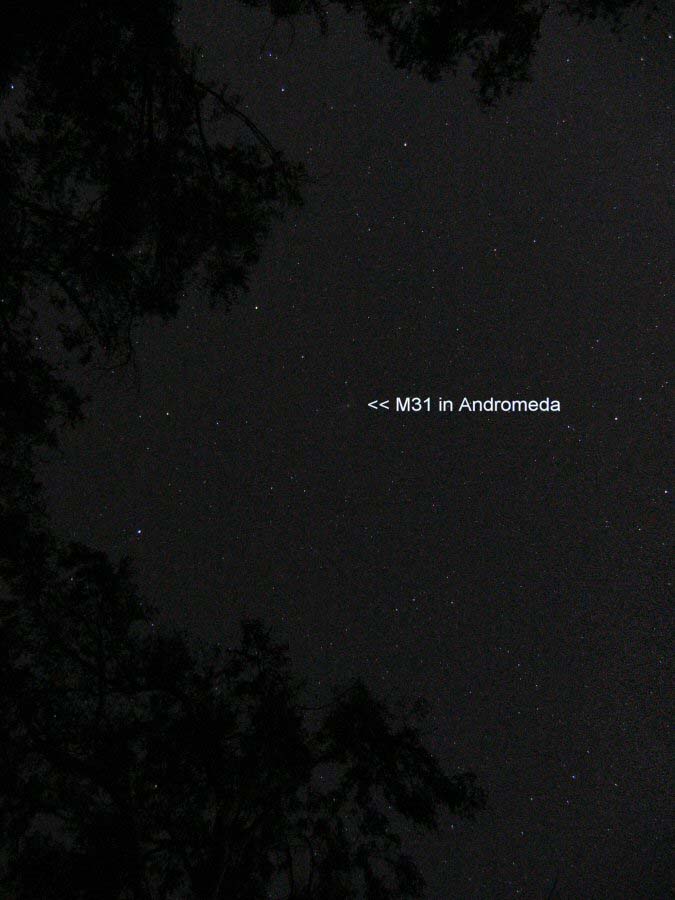ASTROPHOTOGRAPHY: Using Film and Digital Media
Nature Photography | Arizona pix | California pix
FILM

ASTROPHOTOGRAPHY: Using Film and Digital Media |
|
Home | Astronomy and Astrophotography | Useful
Data for Astrophotographers | Astrophotography Time Lapse Nature Photography | Arizona pix | California pix |
|
FILM |
|
 |
|
above: The photo above was taken 12 July 1999 at Lake Hudson
State Park, Michigan, USA. It's a 40 second exposure of the Milky Way centered
on Sagittarius. See this
table for approximate maximum exposure times for unguided film-based imaging.
above: Pleaides star cluster; photo taken in Michigan near
Pioneer, Ohio, Sept. 1997
above: Orion rising out of the east; photo taken near Pioneer, Ohio
above: star trails centered on Polaris (North Star);
photo taken 12 August 1997 in Michigan near Oakshade, Ohio
These above images the best shots out of a few dozen I took in the summer of
1997 and 1999. For all photos, I just used a 35mm camera with a 50mm lens. Film
used was the Fuji SuperHG-800. Camera used was the Pentax ME-Super with a matching
Pentax 50mm lens. Although the equipment I am currently using is limited, I
find that the single greatest factor working against me is the local weather.
NW Ohio and S-SE Michigan is a moisture-ridden area due to nearby Lake Erie
and the local weather patterns. Finding a clear, moonless night is often hard
to come by. The shots above were taken 80km (50mi) West or North-West of my
residence in Toledo. Light pollution is still very evident in these shots despite
countryside locations and image processing (Adobe PhotoShop 4.0).
What camera should I use -- and where can I get it?
As of this writing, (fall 2004) the best price/performance option is still
a used, manual 35mm film camera. I have several but prefer Olympus OM 1 or OM
2 (or OM 2N) models -- mostly due to the excellent Zuiko lens system. I've also
had very good experience with Pentax ME and ME Super. All my cameras and lenses
were purchased at eBay. Use the search box below, entering the models noted
above. (Please note: Used camera merchants rate and price camera based highly
on its cosmetic condition rather than its electrical/mechanical functionality.
You don't have to get a pretty, "mint"-condition camera. If it has
a few dings and scratches, that's just fine. Just make sure the merchant specifically
notes that it is in good operating condition; if this is not stated, contact
the merchant for specifics -- eBay makes this easy to do).
What about film?
Fujicolor Superia X-TRA 800 is a tried-and-true film for basic astrophotography;
it used to be called "SG+ 800" and was highly praised in astronomy
magazines such as Sky & Telescopes and Astronomy. This
web site has some information about Superia (and other films) including
this statement: "Nonetheless, the Fuji Superia films are probably the best
color negative films for astrophotography that are presently available."
Use the information on our Data
for Astrophotographer's page to plan and time your shots.
For more info or advanced astrophotography, please use the information on these
sites:
What else is should be considered essential in a basic amateur astrophotography toolkit?
In Feb 2004, I moved to Los Angeles, California. Vacationing at Laurel Mill Lodge in the Redwoods of Santa Cruz mountains (Loma Prieta region) in late June and early July 2004, I experimented with a relatively inexpensive (and ill-suited-for-the-purpose) digital camera: a 4.0 MP Canon A85. The slowest allowable shutter speed is 15 seconds, which is about 1/2 of what I used for film-based unguided shots. But film isn't digital. The weather of the area is supposed to be clear and dry. Around 3 am, the marine layer comes in (over-casting everything) until late morning, when it burns off. During my 6-day stay, however, the weather was unusually cloudy: i.e. the nights were overcast or hazy. The few clear nights were very clear, apart from the light pollution from nearby by San Jose, Santa Cruz and the Oakland/San Francisco bay area 50 miles to the north.
Here are two shots taken from the lodge.
Lyra at Zenith. It's hard to tell from this image, but the pitch-black area on the left-hand side and upper right-hand corner are trees.
Weather was poor in this image of Scorpius. The clouds were also illuminated by the Moon.

(above) Andromeda at Zenith 20040726-1: Wow! The galaxy became visible after
only 15 second exposure in shot on an inexpensive
digital camera. This picture was taken at Topanga State Park, 12 miles (19
kilometers) North-West
of downtown Los Angeles.
Additional processing done in Jasc
PaintShop Pro 8 and/or Adobe
Photo Elements 2.0.
top of page
Home | Astronomy
and Astrophotography | Useful
Data for Astrophotographers | Astrophotography
Time Lapse
Nature Photography | Arizona
pix | California
pix